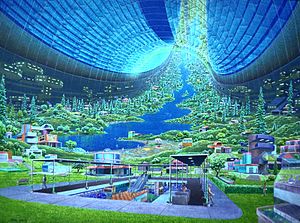L5 Society
From Wikipedia, the free encyclopedia
The L5 Society was founded in 1975 by Carolyn and Keith Henson to promote the space colony ideas of Dr. Gerard K. O'Neill.
The name comes from the L4 and L5 Lagrangian points in the Earth-Moon system proposed as locations for the huge rotating space habitats that Dr. O'Neill envisioned. L4 and L5 are points of stable gravitational equilibrium located along the path of the moon's orbit, 60 degrees ahead or behind it.
An object placed in orbit around L5 (or L4) will remain there indefinitely without having to expend fuel to keep its position, whereas an object placed at L1, L2 or L3 (all points of unstable equilibrium) may have to expend fuel if it drifts off the point.
Contents |
[edit] Founding of L5 Society
Dr. O'Neill's first published paper on the subject, The Colonization of Space, appeared in the journal Physics Today in September 1974. A number of people who later became leaders of the L5 Society got their first exposure to the idea from this article. Among these were a couple from Tucson, Arizona, Carolyn and Keith Henson. The Hensons corresponded with O'Neill and were invited to present a paper on "Closed Ecosystems of High Agricultural Yield" at the 1975 Princeton Conference on Space Manufacturing Facilities, which was organized by O'Neill.
At this conference, Dr. O'Neill merged the Solar Power Satellite (SPS) ideas of Dr. Peter Glaser with his space habitat concepts.
The Hensons incorporated the L5 Society in August 1975, and sent its first 4-page newsletter in September to a sign up list from the conference and Dr. O'Neill's mailing list. The first newsletter included a letter of support from Morris Udall (then a contender for US president) and said "our clearly stated long range goal will be to disband the Society in a mass meeting at L5."
[edit] Moon Treaty, decline of L5 Society and merger with National Space Institute

The peak of L5's influence was the defeat of the Moon Treaty in the US Senate in 1980. Specifically, L5 Society activists campaigned for awareness of the provisions against any form of sovereignty or private property in outer space that would make space colonization impossible and the provisions against any alteration of the environment of any celestial body prohibiting terraforming. Leigh Ratiner, a Washington lawyer/lobbyist, was instrumental in this effort. (Leigh was later forced out of his law firm due to his successful representation of Inslaw.)
Though economic analysis indicated the SPS/space colony concept had merit, it foundered on short political and economic horizons and the fact that the transport cost to space was about 10,000 times too high for individuals to fund when compared to the Plymouth Rock and Mormon colonies. (See the chapter "Pilgrims, Saints and Spacemen" in Freeman Dyson's Disturbing the Universe for an analysis.)
In 1986 the Society, which had grown to about 10,000 members, merged with the 25,000 member National Space Institute, founded by famed German rocket engineer and Project Apollo program manager Dr.Wernher von Braun of NASA's Marshall Space Flight Center to form the present-day National Space Society.
While the L5 Society failed to achieve the goal of human settlements in space, it served as a focal point for many of the people who later became known in fields such as nanotechnology, memetics, extropianism, cryonics, transhumanism, artificial intelligence and Tether propulsion such as Dr. K. Eric Drexler, Dr. Robert Forward, Dr. Hans Moravec and many others. An interesting journalistic account can be found in Great Mambo Chicken and the Transhuman Condition by Ed Regis (1990 - ISBN 0-201-09258-1).
The consensus by the late 1990s among those who were active in the early years of the L5 Society is that space colonies or even a serious human presence in space is unlikely before the Technological Singularity decades into the future. Most of them regret the opportunity was missed, not least because Space solar power would solve some of the world's urgent problems, particularly energy and global warming.
[edit] L5 News

L5 News was the newsletter of the L5 Society reporting on space habitat development and related space issues. The L5 News was published from September 1975 until April 1987, when the merger with the National Space Institute was completed and the newly formed National Space Society began publication of its own magazine, Ad Astra.
[edit] See also
[edit] External links
- 1979 UN Declaration on the Moon (Moon Treaty)
- L5 News Index for 1975
- L5 News Index for 1976
- L5 News Index for 1977
- L5 News Index for 1978
- L5 News Index for 1979
- L5 News articles in the 1980s
- NSS Chapters Story
- NSS Worldwide
- National Space Society Official website
- Ad Astra Online Online edition of magazine
- National Space Society Chapters Network Resources for NSS chapters, members and space activists.




